Daydreaming travel - Streets of São Paulo #3 / Calles de São Paulo #3 (eng/esp).
This time we go to Liberdade , the popular Japanese neighborhood in São Paulo. It offers many good things for tourists, you can find the Japanese garden and try their typical food. How not to love the red lanterns, traditional restaurants and small? It's a bit of Asia in Brazil. But while walking around the neighborhood, looking for good sushi and taking pictures of the most hidden corners of the neighborhood, I stopped to think about how the Japanese community came to stop there? After all, what is the history of the Liberdade neighborhood in São Paulo?
Esta vez vamos a Liberdade, el popular barrio japones en São Paulo. Ofrece muchas cosas buenas para los turistas, puedes encontrar el jardín japonés y probar su comida típica. ¿Cómo no encantarse con las linternas rojas, restaurantes tradicionales y pequeñas? Es un pedacito de Asia en Brasil. Pero mientras caminaba por el barrio, buscando un buen sushi y sacando fotos de los rincones más recónditos del barrio, me detuve a pensar en cómo la comunidad japonesa vino a parar allí? Después de todo, ¿Cuál es la historia del barrio de Liberdade en São Paulo?
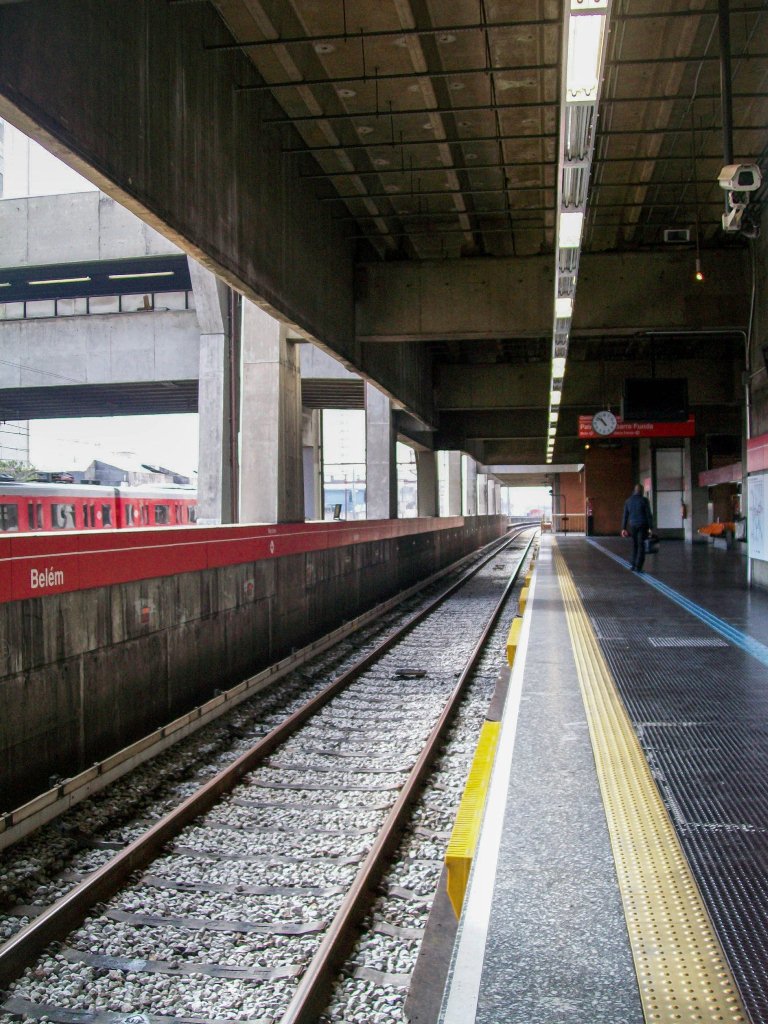
Tomando el metro al próximo destino.
After wandering around and asking about the place, I was able to make a series of conclusions, but definitely not accurate so ... I turned to my best friend Google and gathered enough information to make sense of the story.
Después de merodear y preguntar por el lugar, pude armar una serie de conclusiones, pero definitivamente nada certeras así que.. Recurrí a mi mejor amigo Google y junté la información suficiente para dar sentido a la historia.
A very dark past
Un pasado muy oscuro
In XVII century, this district was still all well deserted, the region was considered a peripheral area of the city. It was known as "Barrio de la Pólvora" , on account of an old "Casa de la Pólvora" (house of gunpowder), built in 1754.
Many years ago, there was a gallows where today is the Plaza de la Libertad. For several years, blacks and fugitive slaves were executed there. For that reason, the place was baptized with an unattractive name: Largo da Força (Force width). The terrible executions only stopped in 1870, when the death penalty by hanging was extinguished in Brazil.
En el siglo XVII, este barrio todavía estaba todo bien desierto, la región era considerada una zona periférica de la ciudad. Fue conocida como barrio de la Pólvora, por cuenta de una antigua "Casa de la Pólvora", construida en 1754. Hace muchos años, existía una horca donde hoy está la Plaza de la Libertad. Por varios años, allí se ejecutaron negros y esclavos fugitivos. Por eso, el lugar fue bautizado con un nombre nada atractivo: "Largo da Força". Las terribles ejecuciones sólo pararon en 1870, cuando la pena de muerte por ahorcamiento fue extinguida en Brasil.

Suzuranto es el nombre de las linternas típicas que decoran e iluminan las calles, se instalaron alrededor de 1970.
The origin of the name Liberdade
El origen del nombre Liberdade
Liberdade means "freedom" in portuguese. When the executions ended, the name was replaced. The Plaza de la Libertad was born that way. There are some hypotheses after the election of that name. The most popular story is where a soldier hangs who complained about paying back the Portuguese crown. The rope of the hanging broke three times and the soldier ended up being killed with blows. The massacre sensitized the crowd, who shouted "Freedom, Freedom!".
Liberdade significa "libertad" en portugués. Cuando las ejecuciones acabaron, el nombre fue reemplazado. Nació así la Plaza de la Libertad. Hay algunas hipótesis tras la elección de ese nombre. La historia más popular, es donde cuelga un soldado que se quejó de volver a pagar a la corona portuguesa. La cuerda del ahorcamiento rompió tres veces y el soldado acabó siendo asesinado con golpes. La masacre sensibilizó a la multitud, que gritaron "Libertad, Libertad!".
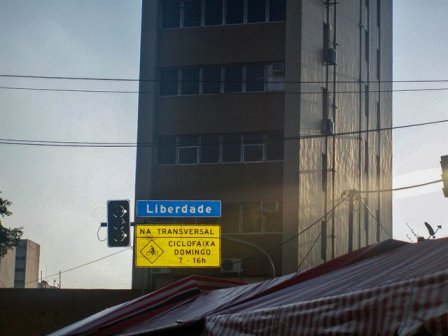 | 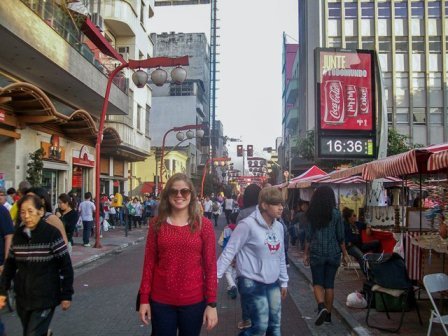 |
Sí, esa soy yo pretendiendo posar en medio de Liberdade.
The Japanese arrival
La llegada japonesa
According to the locals, the Japanese were not the first to arrive in the area (although some old women have said yes). The first to live there were some former slaves and their descendants. Years later, Italian and Portuguese immigrants also arrived. They were building small houses that had a "half-basement." These houses had a very low rental price, Japanese immigrants arrived in the early twentieth century, occupying those spaces, especially for the price and proximity of the center.
De acuerdo con los lugareños, los japoneses no fueron los primeros en llegar a la zona (aunque unas ancianas me hayan dicho que sí). Los primeros en vivir ahí fueron algunos ex esclavos y sus descendientes. Años después, los inmigrantes italianos y portugueses también llegaron. Ellos fueron construyendo pequeñas casas que tenían un "medio-sótano”. Estas casas tenían un precio de alquiler muy bajo. Los inmigrantes japoneses llegaron a principios del siglo XX, ocupando esos espacios, especialmente por el precio y cercanía del centro.
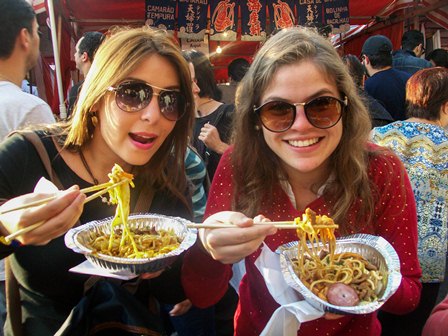 | 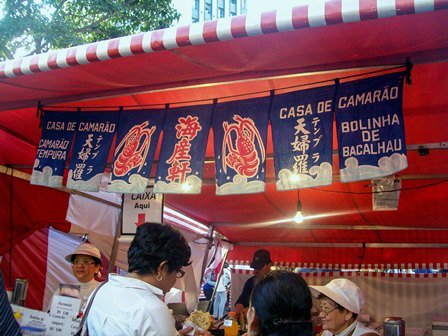 |
Acá esos fideos, con mi prima que me acompañó durante el viaje.
Now, not everything in this post is about history. There are some interesting things I want to share with you. I mentioned you could find some japanese typical food, from some sort of fried shrimps and the noodles I ordered (I forgot the name, but they were pretty good). Also, there's a small garden inspired by oriental culture, One particular thing you cand find at the entrance of the neighborhood, on "Galvão Bueno" street, is the Torri . It's a traditional Japanese door, also linked to Shintoism , which is related to the entrance or proximity of a sanctuary.
Read about shintosim here
Ahora, no todo en esta publicación es sobre historia. Hay algunas cosas interesantes que quiero compartir con ustedes. Mencioné que podrías encontrar comida típica japonesa, de algún tipo de camarones fritos y los fideos que pedí (me olvidé el nombre, pero eran bastante buenos). Además, hay un pequeño jardín inspirado en la cultura oriental, una cosa particular que puedes encontrar en la entrada del vecindario, en la calle "Galvão Bueno" , es el Torri. Es una puerta japonesa tradicional, también vinculada al sintoísmo, que está relacionada con la entrada o la proximidad de un santuario.
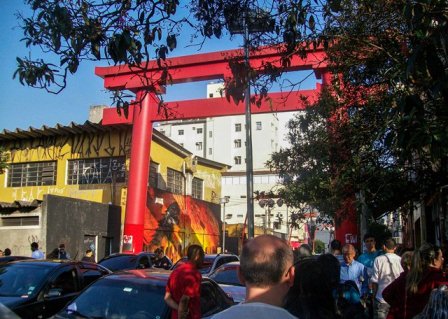 |  |
Finally, I share with you a bit of humor.. I could not miss a bit of street art, this time nothing more and nothing less than a painting of Godzilla, precisely in the Japanese district.
Para finalizar, comparto con ustedes un poco de humor.. No podía faltar un poco de arte callejero, esta vez nada más y nada menos que una pintura de Godzilla, precisamente en el barrio japonés.
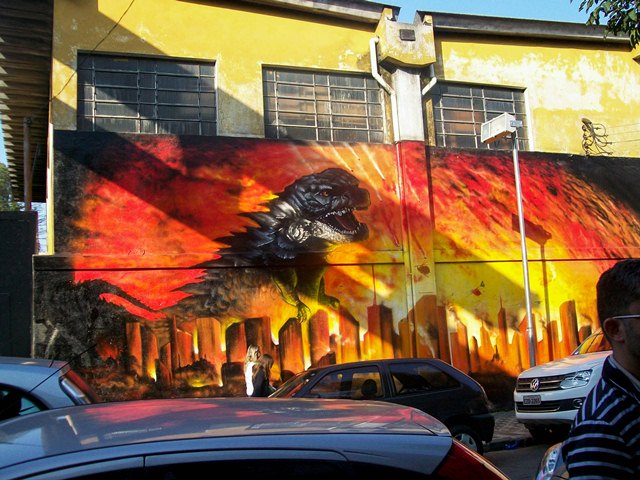
Tenía que ser Godzila, fue muy gracioso.
I have a lot more photos of this trip, I'll show you in another post!
World of Photography
>Visit the website<
You have earned 5.30 XP for sharing your photo!
Daily photos: 1/2
Daily comments: 0/5
Multiplier: 1.06
Server time: 00:14:05
Total XP: 198.00/200.00
Total Photos: 36
Total comments: 12
Total contest wins: 0
Follow: @photocontests
Join the Discord channel: click!
Play and win SBD: @fairlotto
Daily Steem Statistics: @dailysteemreport
Learn how to program Steem-Python applications: @steempytutorials
Developed and sponsored by: @juliank
I'm glad I didn't live back in those days, it was definitly a very dark time. Interesting about the Japanese not being the first to arrive.
Thanks for the tour and such interesting information
Always glad to do it! Thanks for stopping by, cheers! :)
A pleasure to visit
Thanks for sharing the history behind the locations you visited. well written blog :-)
Congratulations @vanessapineda7! You have completed some achievement on Steemit and have been rewarded with new badge(s) :
Click on any badge to view your own Board of Honor on SteemitBoard.
For more information about SteemitBoard, click here
If you no longer want to receive notifications, reply to this comment with the word
STOPDo not miss the last announcement from @steemitboard!